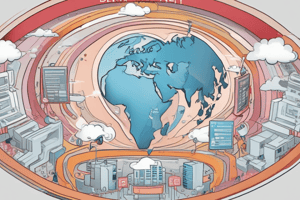Podcast
Questions and Answers
In the RACI model, who has the overall authority for the task?
In the RACI model, who has the overall authority for the task?
What is the key benefit of defining roles clearly?
What is the key benefit of defining roles clearly?
In the context of service management processes, who will be accountable for all process activities in the RACI model?
In the context of service management processes, who will be accountable for all process activities in the RACI model?
What does the sponsor aim to do in the scenario involving the purchase of new laptops for sales representatives?
What does the sponsor aim to do in the scenario involving the purchase of new laptops for sales representatives?
Signup and view all the answers
Who might be consulted to get a task done in the RACI model?
Who might be consulted to get a task done in the RACI model?
Signup and view all the answers
What is a key value example for service provider employees according to Table 2?
What is a key value example for service provider employees according to Table 2?
Signup and view all the answers
How many people can be Responsible in the RACI model for a given task?
How many people can be Responsible in the RACI model for a given task?
Signup and view all the answers
'One individual might act as the customer, the user and the sponsor for a service' - what real-world example is provided to explain this concept?
'One individual might act as the customer, the user and the sponsor for a service' - what real-world example is provided to explain this concept?
Signup and view all the answers
'Resources can be drawn from different functional areas within an organization' - what makes it challenging for line managers according to the text?
'Resources can be drawn from different functional areas within an organization' - what makes it challenging for line managers according to the text?
Signup and view all the answers
'Sometimes resources are Consulted to get a task done.' - Who could these consulted resources be?
'Sometimes resources are Consulted to get a task done.' - Who could these consulted resources be?
Signup and view all the answers
The RACI model stands for Responsible, Accountable, Consulted, and ______.
The RACI model stands for Responsible, Accountable, Consulted, and ______.
Signup and view all the answers
In the scenario of purchasing new laptops for sales representatives, the ______ works in procurement and aims to purchase the cheapest laptops possible.
In the scenario of purchasing new laptops for sales representatives, the ______ works in procurement and aims to purchase the cheapest laptops possible.
Signup and view all the answers
The service provider employees receive job satisfaction, financial and non-financial rewards, and personal ______.
The service provider employees receive job satisfaction, financial and non-financial rewards, and personal ______.
Signup and view all the answers
The RACI model helps in tracking who is doing what by defining roles as Responsible, Accountable, ______, and Informed.
The RACI model helps in tracking who is doing what by defining roles as Responsible, Accountable, ______, and Informed.
Signup and view all the answers
The customer in the scenario of providing new laptops to a team of sales representatives is the sales team ______.
The customer in the scenario of providing new laptops to a team of sales representatives is the sales team ______.
Signup and view all the answers
The key benefit of defining roles clearly is better ______.
The key benefit of defining roles clearly is better ______.
Signup and view all the answers
The stakeholders who need to track and understand the progress of a task are classified as ______ in the RACI model.
The stakeholders who need to track and understand the progress of a task are classified as ______ in the RACI model.
Signup and view all the answers
The sponsor, customer, and user roles in a service can sometimes be fulfilled by ______ individual.
The sponsor, customer, and user roles in a service can sometimes be fulfilled by ______ individual.
Signup and view all the answers
The RACI model is used to manage resources and roles for the delivery of a piece of ______ or task.
The RACI model is used to manage resources and roles for the delivery of a piece of ______ or task.
Signup and view all the answers
In the RACI model, only one person can be ______ for any task.
In the RACI model, only one person can be ______ for any task.
Signup and view all the answers
The RACI model is primarily used for tracking who is doing what in an organization.
The RACI model is primarily used for tracking who is doing what in an organization.
Signup and view all the answers
In the RACI model, the person who is Responsible for a task has the overall authority for that task.
In the RACI model, the person who is Responsible for a task has the overall authority for that task.
Signup and view all the answers
Stakeholders classified as 'Service provider employees' receive financial benefits such as dividends.
Stakeholders classified as 'Service provider employees' receive financial benefits such as dividends.
Signup and view all the answers
The scenario involving the purchase of new laptops for sales representatives illustrates the importance of clear role definition.
The scenario involving the purchase of new laptops for sales representatives illustrates the importance of clear role definition.
Signup and view all the answers
All tasks within the RACI model must have exactly one person who is Consulted for that task.
All tasks within the RACI model must have exactly one person who is Consulted for that task.
Signup and view all the answers
Match the following RACI model components with their descriptions:
Match the following RACI model components with their descriptions:
Signup and view all the answers
Match the stakeholders with their respective value examples according to Table 2:
Match the stakeholders with their respective value examples according to Table 2:
Signup and view all the answers
Match the following roles with their example scenarios:
Match the following roles with their example scenarios:
Signup and view all the answers
Match the provided real-world examples with their corresponding concept:
Match the provided real-world examples with their corresponding concept:
Signup and view all the answers
Match the following benefits with their descriptions:
Match the following benefits with their descriptions:
Signup and view all the answers
Study Notes
Service Management Roles and Relationships
- A service provider can be part of the same organisation as a consumer or an external organisation.
- A service provider organisation must understand who its customers or consumers are, and which other stakeholders are part of its wider service relationships.
Stakeholders
- A stakeholder is "a person or organization that has an interest or involvement in an organization, product, service, practice, or other entity".
- Stakeholders can be anyone - internal or external to the organisation.
- Examples of stakeholders: suppliers and partners, shareholders and investors, auditors, employees.
Service Relationships
- A service relationship is "a co-operation between a service provider and a service consumer".
- Service relationships include service provision, service consumption, and service relationship management.
- Effective service relationship management brings benefits for both the service provider organisation and the consumer.
Service Consumer
- The service consumer is the person or organisation receiving a service.
- Most organisations will act as service providers and service consumers as part of normal service delivery.
- Consumer is a broad term that includes customer, user, and sponsor.
Roles and Responsibilities
- Defining roles clearly supports better communication, better relationships, and better stakeholder management.
- The roles within the 'consumer' definition can have different and conflicting expectations about value, agreeing essential requirements, and how much they are prepared to pay.
RACI Models for Role Mapping
- The RACI (Responsible, Accountable, Consulted and Informed) model is used to track who is doing what.
- RACI models are used to manage resources and roles for the delivery of a piece of work or task.
- Only one person can be Accountable for any task.
- Any number of people can be Responsible as part of the RACI model.
- Resources need to be tracked to ensure they are available when required.
Service Management Roles
- Service provider, stakeholder, service relationship, consumer (customer, user, sponsor).
- Roles are carried out by people and need to be clearly defined so that those people understand what they are supposed to do.
- Clear roles and responsibilities are essential for an effective service management organisation.### Service Management Roles
Service Provider
- The organisation delivering a service
- Can be part of the same organisation as a consumer (e.g. IT department offering services to a sales team) or an external organisation (e.g. software solutions provider selling to customers)
- Must understand who its customers or consumers are, and which other stakeholders are part of its wider service relationships
Stakeholder
- A person or organisation that has an interest or involvement in an organisation, product, service, practice, or other entity
- Can be internal or external to the organisation
- Examples: suppliers and partners, shareholders and investors, auditors, employees
- Service provider organisation needs to build relationships with stakeholders to improve communication and understand their requirements
Service Relationship
- A co-operation between a service provider and a service consumer
- Includes service provision, service consumption, and service relationship management
- Changing perspective from 'making a sale' to managing a relationship can have a big impact on how service providers behave
- Managing service relationships requires the service provider organisation to continue to allocate time and resources after a purchase has been made or a service has been provided
Service Consumer
- The person or organisation receiving a service
- Includes customer, user, and sponsor
- Customer: defines the requirements for a service and takes responsibility for the outcomes of service consumption
- User: uses services
- Sponsor: authorizes budget for service consumption and provides financial or other support for an initiative
- One individual can act as the customer, user, and sponsor for a service
Roles and Relationships
- Clear roles and responsibilities are essential for an effective service management organisation
- Roles are carried out by people and need to be clearly defined
- A single person can fulfill many roles
- ITIL doesn't require hiring lots of new staff, but simply matching the service management roles with the existing IT staff members
Stakeholder Value
- Different stakeholders receive different types of value
- Examples:
- Service consumer: receives benefits from the service and optimises costs and risks
- Service provider: receives funding or loyalty from consumers, supporting business development and reputation enhancement
- Service provider employees: job satisfaction, financial and non-financial rewards, personal development
- Society and community: employment, taxes, corporate social responsibility initiatives
- Charity organisations: financial and non-financial contributions
- Shareholders: financial benefits, such as dividends
RACI Model
- Used to track who is doing what
- Provides clear mapping of roles across different teams in the organisational structure
- RACI (Responsible, Accountable, Consulted, and Informed) model is used to manage resources and roles for delivery of a piece of work or task
- Steps to build a RACI matrix:
- Identify activities
- Identify roles
- Assign RACI codes
Studying That Suits You
Use AI to generate personalized quizzes and flashcards to suit your learning preferences.
Description
Explore the dynamics of service provider relationships within the framework of ITIL, whether they are internal or external to an organization. Learn about identifying customers, consumers, and other stakeholders in service relationships.




